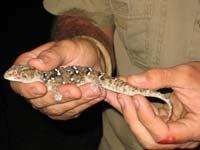“It is in our culture to catch, kill, or cook anything that moves”

The Philippines is among 17 “megadiverse” countries that harbour two-thirds of Earth’s species.
But the Southeast Asian nation of islands is one of the world’s most threatened hotspots, with just 7% of its original forests left and one of the world’s fastest-growing populations that needs ever-greater amounts of land.
A report out of Manila now says that the Philippines’ biodiversity riches makes it a major force in the global illegal wildlife trade, which is worth up to $20 billion annually, according to the Association of Southeast Asian Nations Wildlife Enforcement Network.
The network says wildlife is the world’s third-largest black market trade, surpassed only by arms and drugs.
“It is in our culture to catch, kill, or cook anything that moves,” said Mike Lu, treasurer of the Wild Bird Club of the Philippines, who has observed a dramatic decline in bird species over many years.
Among the higher-profile animal species to have all but vanished in recent years due to hunting are the brown deer and the national bird, a monkey-eating eagle.
And only about 200 tamaraw, a wild buffalo, remain at a protected mountain range.
Some of the prices are astounding.
Several species of geckos, colourful nocturnal lizards, are collected for the alternative medicine trade, with those believed to cure Aids selling for up to $1,200, while some of the rarest Philippine birds of prey are rumoured to fetch upwards of $20,000, according to Lim.
She said trappers - typically poor farmers - got as little as $12 for a coveted Philippine parrot, but middlemen then sold the critically endangered bird for five times that.
President Benigno Aquino’s government, which came to power last year, has stepped up efforts to combat the rampant wildlife trade.
High-profile police raids of pet-shop and trophy suppliers this year have uncovered a wide range of rare or critically endangered species, including sea turtles, snakes and corals.
Protected wildlife used to be openly hawked at big pet markets such as Arranque in Manila’s Chinatown and Cartimar near the financial district.
A recent visit to Arranque found no prohibited species, and market administrator Rene Sese said the shopkeepers now observed a wildlife ban.
“Before that was a practice here. Now they only sell those bred in captivity,” Sese said.
Massive habitat loss compounds the problem, according to Theresa Mundita Lim, head of the government’s protected areas and wildlife bureau.
“One-fifth of our major fauna species will disappear within 20 years’ time if we don’t do something,” Lim said.
With roughly a third of the 95mn Filipinos living on a dollar a day or less, the immediate value of the country’s biodiversity is one of its greatest threats, according to Lim.






